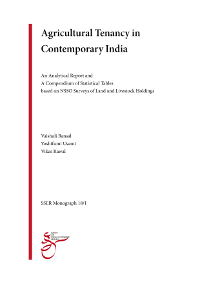Our research on agricultural tenancy in India, of which this volume is the outcome, involved a detailed assessment of the 48th (1991-92), 59th (2002-03) and 70th (2012-13) rounds of the NSSO Surveys of Land and Livestock Holdings (NSSO-SLLH). This assessment included detailed household-by-household corrections to remove a number of inconsistencies in the data. The corrected data are being released for public use along with this volume.
There are three main findings of the analysis of agricultural tenancy in the report. First, there has been a significant increase in the incidence of tenancy between 2002–03 and 2012–13. While there are considerable variations in levels and trends across States and regions, the trends over this decade were in a sharp contrast with the decline in tenancy seen in the NSS data for the preceding three decades. Secondly, the data suggest that landless poor households are increasingly marginalised in tenancy markets as a substantial part of land is leased by large, resource-rich households. Thirdly, the data show that there has been an increase in the share of land leased on fixed-rent tenancy contracts, and in particular, on fixed-rent contracts with payment of rent in the form of money. An increasing participation of large, resource-rich tenants marginalises poor from the lease market and forces them to accept more onerous terms of contracts.
Our assessment of the NSSO Surveys of Land and Livestock Holdings point to the need for NSSO to conduct an integrated survey of agrarian conditions in which comprehensive data on land, land use, production, labour deployment, input use and investment are collected from the same sample of households. In the current scheme of NSSO surveys, crucial aspects of the agrarian economy are captured in different survey schedules, canvassed to different samples of households. There are also other important problems with the design of these surveys which ought to be paid attention.
The second part of this volume presents a detailed compendium of statistical tables on landholdings. A set of 35 tables are provided for twenty most populous States for which survey data were available. In case of States where number of sample observations was substantial, six additional tables are provided for each region of the State.
A committee constituted by the Niti Aayog has recently recommended that agricultural tenancy be freed of all state regulation. Analysis of the NSSO-SLLH data presented in this volume point at continued relevance of state regulation of agricultural tenancy in favour of poor tenants. Although tenancy reform legislation have not been effectively implemented except in a few States, a withdrawal of these regulations, as recommended by the Haque Committee, would only work to further marginalise poor tenants.
See the full report here.
Recommended citation:
Bansal, Vaishali, Usami, Yoshifumi, and Rawal, Vikas (2018), Agricultural Tenancy in Contemporary India: An Analytical Report and A Compendium of Statistical Tables based on NSSO Surveys of Land and Livestock Holdings, SSER Monograph 18/1, Society for Social and Economic Research, New Delhi (available at: http://archive.indianstatistics.org/sserwp/sserwp1801.pdf).

